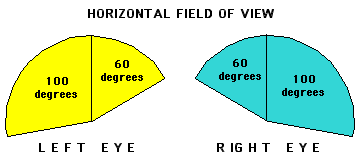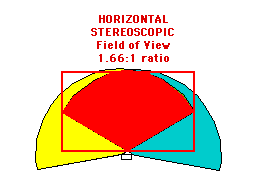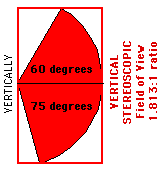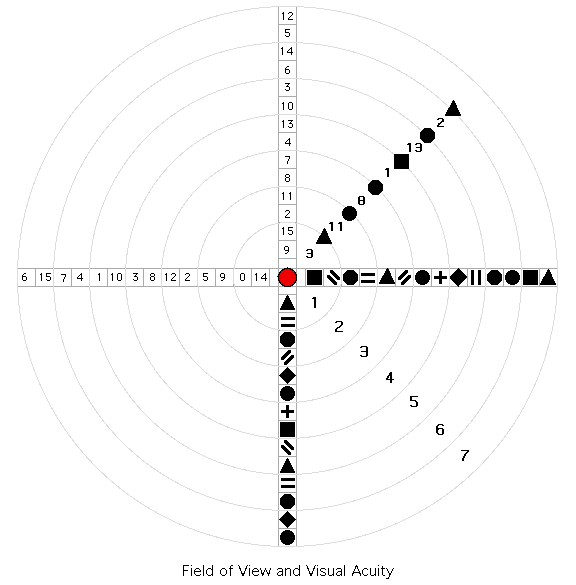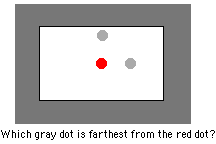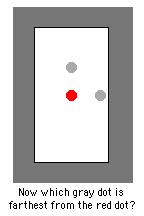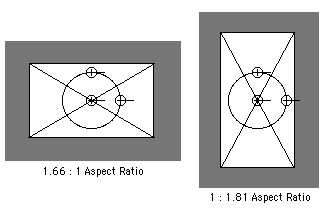HOW we SEE affects WHAT we PERCEIVE
(A way of enhancing the viewers visual experience?)
If you're going to play in the Visual Arts, and wood turning is a visual art, understanding a bit about HOW WE PERCEIVE the world around us can be quite useful. Oddly enough, we learn all sorts of things about Form and Proportions, turning tools and how to sharpen and use them. We learn about wood and wood movement, sanding and finishing. Oddly, if the term "vision" comes up at all, it's usually in the form of "my vision for this piece is / was . . ." - not HOW WE SEE and how that effects WHAT WE PERCEIVE. What follows focuses on our Visual System and how it effects what we " see" , based on what I've gleaned from information found by Googling "Human Visual System", reading books and articles on the subject and asking questions of an optometrist and an opthalmologist.
So let's begin with the physiological - our eyes - and their fields of vision.
Each eye has about a 160 degree HORIZONTAL field of vision, 60 degrees from straight ahead towards the nose, 100 degrees towards and behind the shoulder. In the first 60 degrees" towards the shoulder" the eye can detect color and details. Beyond that we're into peripheral vision - where light and dark can be distinguished and movement can be detected, but not much else.
It's when you OVERLAP the horizontal field of view of BOTH eyes, that things start getting really interesting - and complicated. Now, we're getting two slightly different sets of visual information, two slightly different views of the same thing - Stereoscopic Vision. Within that Stereoscopic Field of Vision we have the added ability to judge not only light and dark, movement, shapes and forms, but also color and DISTANCE - in part of our horizontal field of view - the RED part, well most of the RED part, your nose will block out some that stereoscopic field of view.
Note the Horizontal Stereoscopic Field of View - and its Aspect Ratio.
Our VERTICAL field of vision is also asymetric. We can see more "down" than "up" (assuming you're not eight months pregnant or are a bit overweight). And the Vertical Stereoscopic Field of View has a different, larger ratio, its Aspect Ratio, than our horizontal stereoscopic field of view's aspect ratio. This difference in aspect ratios may explain why a piece On The Lathe that "looks right" can "look NOT right " Off The Lathe.
Within our stereoscopic field of vision, our Visual Acuity, the ability to recognize details, specific colors and specific shapes, is fairly limited, and it gets more limited the closer we are to things. To illustrate how limited our visual acuity is, look at the following illustration. In the center of the image is a red dot, surrounded by numbers, shapes and lines.
Stare directly at the RED DOT and note how far from it you can still distinguish between the surrounding numbers, shapes and lines -WITHOUT MOVING YOUR EYES. Notice that the closer you are to the illustration, the less of the surroundings details you can PERCEIIVE. Also notice that, as you move away from the illustration, the same thing occurs - you begin losing the details. You can see more of the "forest" and less of the "trees". Somewhere between TOO CLOSE and TOO FAR is your Distance of Maximum Visual Acuity
You can download the illustration, print it and tape the printed version to the wall - at your eye height - then find out where your Distance of Maximum Visual Acuity is. It's likely to be somewhere between 16 and 30 inches. And THAT is where a viewer of your turning will see the most details in your piece. BUT - that close, the viewer probably can't see the profile and proportions of the piece that you spent so much time to design and turn. And THAT is what all of this is about - and what I think I've found a way around - to have a way to design a piece so that when viewed, lets the viewer see BOTH the profile and proportions AND the details of the piece - simultaneously - rather than one OR the other. (i'll get to HOW to do that later - honest.)
"OK - so what? What does all that have to do with turning?" you may ask.
Let me see if I can show you the "So what".
The figure to the left .in the horizontal orientation. has the same HORIZONTAL ASPECT RATIO as our eyes - for our stereoscopic horizontal field of view. The figure to the right. in the vertical orientation, has the same VERTICAL ASPECT RATIO as our eyes' stereoscopic vertical field of view. The two fields of view are DIFFERENT. The figure on the left has a 1.66 : 1 aspect ratio and the figure on the right has a 1 : 1.81 aspect ratio. So our Vertical Aspect Ratio is about 10% greater than our Horizontal Aspect Ratio.
In BOTH illustrations, the Gray Dots are exactly the same distance from the Red Dot. But because the different Aspect Ratio of the two examples,. the distances may not APPEAR to be the same, especially in the vertical orientation illustration, the dot on the right appearing farther from the red dot than does gray dot above the red dot)
Let's get into how our Visual System actually works.
We tend to over simplify things. If you even think of how we see things, you may think in terms of an opaque projector of some sort. Light bounces off something, comes through the lens of your eye and gets somehow projected onto the visual cortex of the brain - the display screen of our mind's eye. The brain watches the screen and sees what's out there.
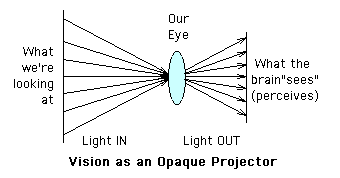
But our Visual System is far more complex and does far more than merely pass light through a lense onto a mental screen.
Here's a more realistic, but still very simplified version of our Visual System, and a pretty amazing thing it is - providing our mind with WHAT and WHERE.
WHAT are we seeing and WHERE is it in our field of view."
There is a LOT that goes on between "out there" and "in here" - where we PERCEIVE things
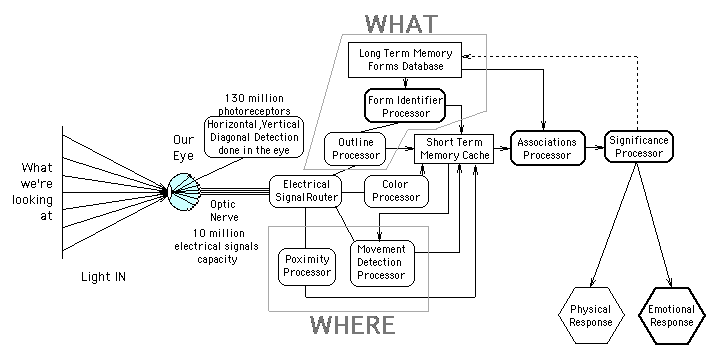
The eye's 130 million+ light receptors are actually types of brain cell, capable of not only detecting light as shades of gray and detecting colors, but also identifying the orientation of lines, noticing movement. and identifying Closer / Farther relationships. There has to be some pre-processing of the visual data IN the eye, since the pipeline to carry visual data to the rest of the brain, the Optic Nerve, has far less capacity than the visual data detected by the photo receptors in the eye itself. The Optic Nerve has a "bandwidth capacity" of only about 2 million signals. So the eye itself does the equivalent of about a 60:1 compression of the data it senses with its light receptors - BEFORE it send signals to the optic nerve. That alone is pretty amazing.
Once the pre-processed data sent down the optic nerve reaches the brain , the brain does an astounding amount of visual data processing before it passes on information to the part of the brain that controls what we PERCEIVE - and - how we respond, both physically AND emotionally, to what we perceive. And what we PERCEIVE and what actually IS - ain't always the same.
The first thing you should be aware of is that what we perceive is contextual - not only of the object being viewed and its physical context - but our personal context as well, both physical and emotional. You see, our brain not only takes in and processes information from our "senses", it also is good at "connecting the dots", combining AND associating new information from our senses - with all sorts of other things we've stored away in our memories - for future use.
Here are some examples of how what we PERCEIVE and what IS - can be different.
We'll start with a Black Square and a White Square on a high contrast background.
Here's a BLACK SQUARE on a WHITE BACKGROUND and a WHTE SQUARE on a BLACK BACKGROUND.
Which square APPEARS larger?
Which square appears closer?
 \
\
The black square and the white square are actully exactly the same size.
But the White Square on the Black Background APPEARS larger than the Black Square on the White Background.
The White Square may also appear to be CLOSER than the Black Square
What about changing the contrast between the object and its background?
How will that effect the PERCEIVED size of the object?
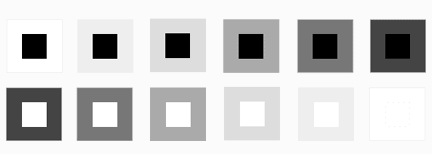
If you look acrossed each row, though the contrast between the object
and its background is changing, the apparent SIZE of the object does not.
What about Busy Backgrounds?
How does that effect the PERCEIVED size of the object you're viewing?
What Busy Backgrounds appear to do is make finding the outline of the object
more difficult to see, to visually separate the object from its background.
The effect is to introduce a Visual Ambiguity,
which takes a bit more brain power and processing time to work out What's There and Where is it.
If one of the purposes of The Visual Arts is to get and hold a viewer's attention . . .
and maybe to play with it - giving it ambiguities to resolve might just do the trick : )
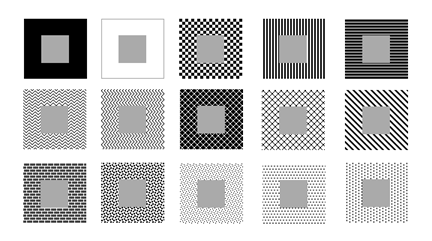
(Did you notice that the one with the DIAGONAL LINES seems to make your eyes jump back and forth between those lines and the square?)
Let's look at CONTEXT in another way.
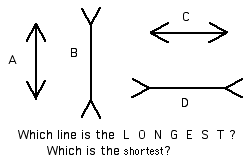
Let's simplify things a little and tone down the distractions
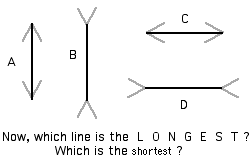
Let me make your choices even easier.
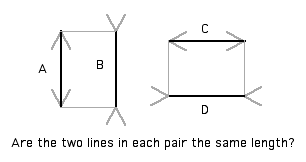
:
:
:
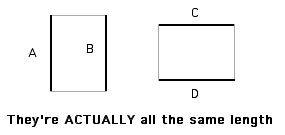
An important thing to be aware of is that
WHAT we "SEE" is CONTEXTUAL .
If you want to hide something and can't actually put it out of sight - surround it with visual distractions. On the other hand, if you want something to be perceived as you intend it to be perceived - get it away from other things. If you want your piece to look good - don't bury it among a bunch of other pieces. Two or three pieces on a shelf or pedestal may be fine if there's enough space between them. Eight or ten pieces close to each other? Not so good. It's the old Can't See The Forest For The Trees thing.
What about Orientation?
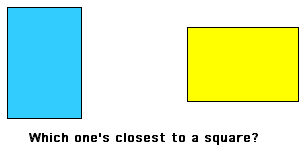
Does something standing with its longer dimension vertical appear taller and narrower than it actually is? Conversely, does laying something on its side so its longer dimension is horizontal make it appear wider than it actually is - and shorter than it actually is - or not?.
It turns out that the Yellow Rectangle will probably look closer to a square than the Blue Rectangle- perhaps due to the fact that our Vertical Stereoscopic Field of Vision "aspect ratio" is about 10 % larger than our Horizontal Stereoscopic Field of Vision's "aspect ratio"( which was covered earlier).
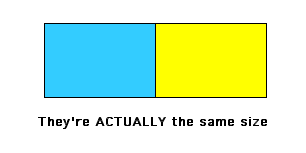
So ORIENTATION can effect your PERCEPTION.
This is probably why proportions and profiles
that look great while ON the lathe,
may not look so good OFF the lathe.
So when you're turning, either take the piece off the lathe and stand it upright
|- or-
take some digital photos, rotate the image 90 degrees
and then see if things still look right.
What about LUMINOSITY and RELATIVE LOCATION?
How do they effect our PERCEPTION?
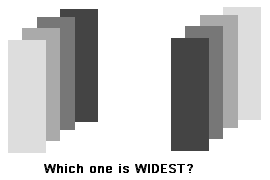
Is the one at the back wider than the one at the front?
What about COLOR? How does COLOR effect our PERCEPTION?
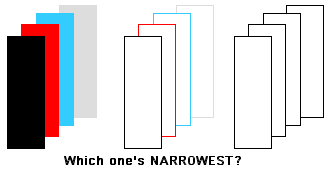
:
:
:
:
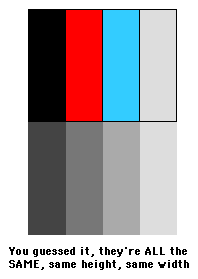
Seems COLOR doesn't effect PERCEIVED SIZE much.
B U T . . .
"In Front Of / In Back Of" DOES effect what we PERCEIVE.
Here's what I think is happening with this In Front Of In Back Of thing.
We expect that if the tall rectangles are all actually the same height and width, that, due to perspective, the farther back you go, the shorter and narrower they SHOULD appear. So we make a mental adjustment - mentally scaling things towards the back UP to adjust for an assumed perspective distortion, which, in this case, IS NOT THERE.
What about PLUMB?
Our visual system seems to be very attuned to PLUMB. A picture or painting hanging on a wall "crooked" bugs us. A wall or door opening that leans, even just a little, will be noticed as "not right". We live in PLUMB and Right Angle CORNERS - our rooms, houses, our offices, our books, our keyboard and display, our laptops, or TVs - square corners, straight lines. Trees can lean, and don't have edges and corners and that's OK with our visual system, natures doesn't use Straight, Square, Plumb much. In fact, it seems man made things are the only things that are made up of straight lines, square corners and plumb vertical elements.
Let's see if you can pick out what Ain't Plumb
.Which of these shapes is "plumb"?
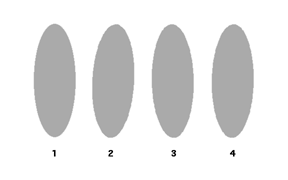
:
:
:
:
Let's see if you were right.
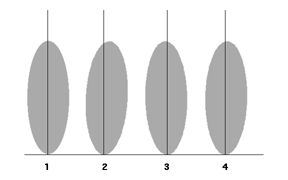
Figure 1 is the only one that's "plumb".
Figure 2 leans 3 degrees to the right.
Figure 3 leans left by only 1 degree.
Figure 4 leans right by just 1 degree.
Even a 1 degree tilt will be noticable as "not right", even if it isn't conscioulsy noticed.
Without a Horizon Line as a visual reference, it's more difficult to judge Plumb.
You may have seen a hollow form with a neck that's offset to the side from where it should be.
Think of one of those pieces you've seen that looks like a pouch of gold, the top drawn together and tied, the bag leaning a bit.
Makes for a very interesting piece that holds your attention.
"NEGATIVE SPACE
"seeing" things that aren't actually there
Negative Space sounds like Art Speak - for Holes. William Hunter, a well known wood artist, who create forms on a lathe then carves and sculpts them up, used an interesting term for Negative Space - The Presence of Abscence. Whatever you want to call it, it's something you might consider to add to your Visual Arts Tool Box because, if used well, can add interest to a piece, paradoxically, by taking away stuff.
Here's a classic example of using "the presence of abscence", three PAC MAN circles each with a wedge removed. Because of the way our Visual System works, its nearly impossible to see the three Pac Men, without seeing the white triangle between them. The visual phenomenon is most obvious when the Pac Men are very dark. But even when they're almost white, you'll still see the white triangle between them - EVEN THOUGH IT ISN'T ACTUALLY THERE. And it doesn't matter how the set of three Pac Men are oriented - you'll still see what isn't there - the white triangle. Works with five and six point stars as well. This phemenon exploits our visual system's "connect the dots" processing component
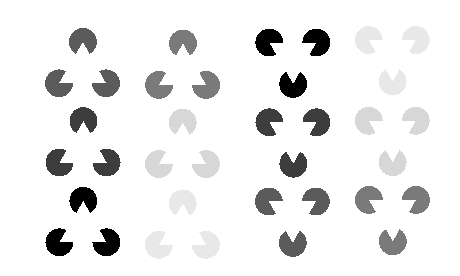
Now that you've got a feel for some of how our Visual System works and how that effects what we perceive, let's get to something that got me looking into how to "trick" it so that we perceive both the DESIGNED IN PROFILE SIDE VIEW - AND - details of a piece - simultaneously.
